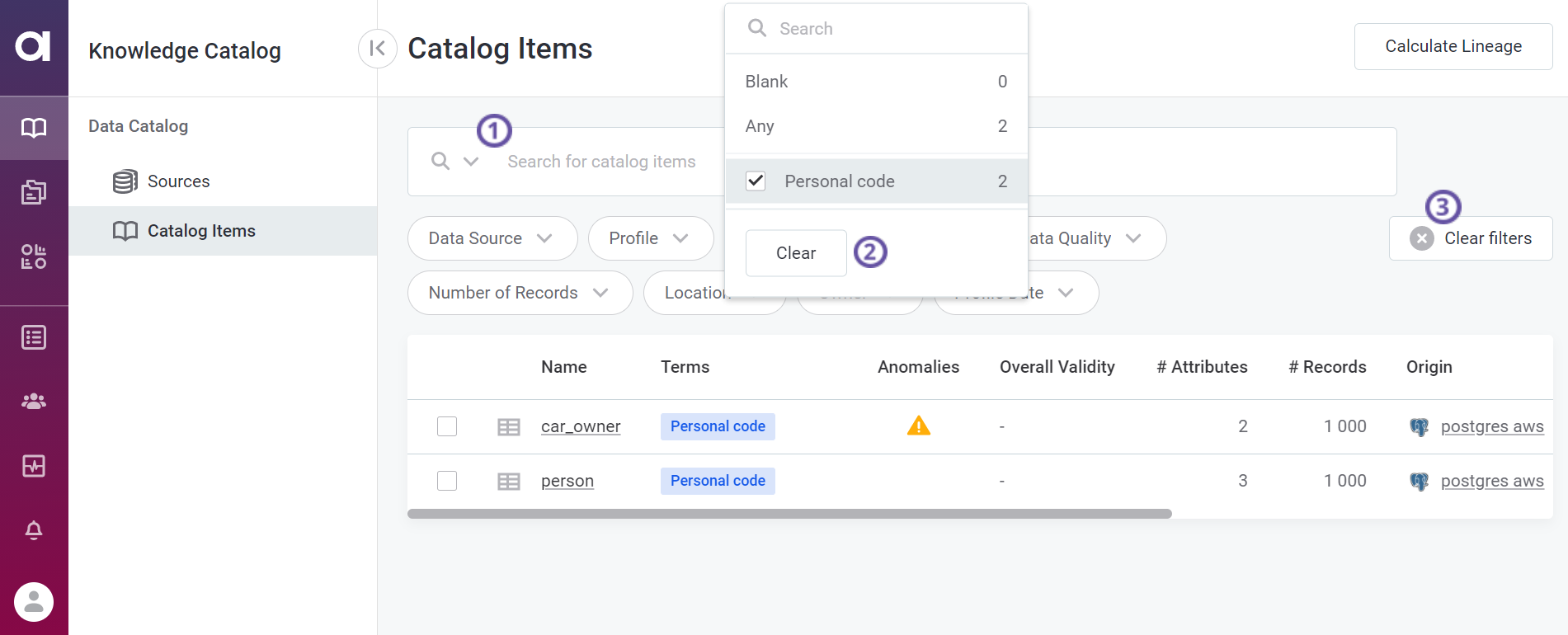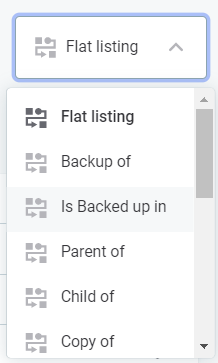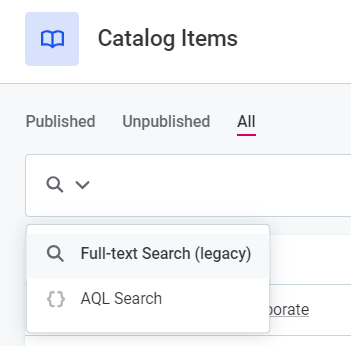Search
One of the key features of Ataccama ONE is a powerful search engine that lets business users easily find what they are looking for while also allowing technical users to execute complex search queries. The search combines full-text and filtering capabilities to query entities based on metadata.
Search options are restricted to the currently selected navigation section. For example, using the search bar in Catalog Items only return results found within that entity and configured areas of search on this entity.
| If you reached this page from the application, it means that the full-text search is not configured on the entity you were browsing. If this is the case, proceed with Search when full-text search is not configured. |
Overview
There are three search modes available:
-
Full-text search in navigation sections uses Elasticsearch technology. The search levels and locations can be customized (this is done in Global Settings > Search Configurations). It is supported on main listing entities with direct reference to the metadata and the flat listing views of hierarchical entities. For example, Elasticsearch will work in the Terms section, but it won’t work in Business Terms since the entities there don’t refer to metadata directly but to Terms*.
-
Full-text search legacy mode is powered by Metadata Management Module (MMM) and used as a fallback option when the default full-text search is unavailable or not configured. It searches through asset names in entity listings and cannot be configured.
-
AQL search is the in-house query language for more complex search requests on entity listings.
How full-text search works
| Elastic-powered (full-text) search currently can be configured only in navigation sections that are configured to list all instances of a given entity (i.e., Catalog Items, Rules, Terms). The configuration is therefore defined per entity type. |
When using full-text search, if your search contains more than one word, each word is processed as a standalone query with the OR operator between the queries.
For example, searching for mail contact returns all findings the contain the word mail or contact.
When searching in tabs, you can choose whether your query should be split (with the OR operator applied between queries) or treated as a single request. By default, your search query is processed at once regardless of how many words it contains (that is, the whole expression is searched as a single query).
If you prefer to search using multiple queries at the same time, enter your query and press Enter or select the search icon. Next, enter another query in the search bar and press Enter again. Repeat this as many times as needed.

Consider the following when searching:
-
Search is case-insensitive.
-
Non-alphanumeric characters are used as delimiters.
-
Stop words are not considered (for example,
a,the,is,are). -
Search terms are stemmed using algorithmic stemmers.
-
Hyphenated words are supported.
-
Concatenated words are supported (for example,
deliveryaddress,postalcode). -
There is support for search-as-you-type (for example,
custwould returncustomersandcustom).
The relevance of results is determined using the default full-text search settings with fixed boosting.
For example, when searching catalog items, the results might be displayed in the following order, starting from the highest to lowest priority:
-
Catalog item name.
-
Term name, regardless of where it is assigned.
-
Attribute name.
-
Everything else.
Search only finds published entities. Entities which have not yet been published and are still in draft state or waiting for approval will not be found.
| If Elasticsearch is not behaving as expected, for example, no search results are returned or items that you expect to appear based on your search criteria are not displayed, it may require reindexing. Please speak to an admin user. |
Search in navigation sections
Enter your search query in the search bar (1). The relevant parts of your query are highlighted in the results.
| To get a better understanding of why some results are shown instead of others, see How full-text search works. |
To narrow down the search results further, apply filters.
If a filter is grayed out, it means no matches are found in your results.
If you combine several different filters, the operator between them is AND.
Within filters, the operator between your selections is always OR.
| In filters, (Blank) can be used in combination with other selected items, Any cannot. |
To remove an individual filter, expand it and select Clear (2). To remove all filters, select Clear filters (3).
If your search returned no results, you can remove all conditions defined by selecting Clear search criteria.

| A number of predefined filters is available for each entity. These can be configured if needed. See Configure Full-text Search. |
Sort search results
Sort your search results to prioritize those relevant to your request.
When you sort search results manually, this overrides the default sorting by relevance. The default sorting is applied again after you clear the current sort.
To sort, use the arrow icon next to the column you want to sort by:
-
To sort in descending order, click once.
-
To sort in ascending order, click twice.
-
To remove sorting, click three times.
Search on hierarchical entities
When the full-text search is configured on entities that contain hierarchies, such as rules or terms, there are multiple options for viewing and sorting search results.
| The full-text search in navigation sections is only available with the Flat listing view. In other views, the legacy full-text search or AQL search are used instead. See Search when full-text search is not configured. |
To change the view, go to the entity listing tab, for example, Terms. In the listing view options, select one from the following:

-
Flat listing - General listing of all items.
-
Backup of - Items that are another’s item backup.
-
Is Backed up in - The original items that have a backup in other locations.
-
Parent of - Items that have children.
-
Child of - Items that have parent items.
-
Copy of - Items that are copies of other items.
-
Sample of - Samples of other items.
-
Is in Sample - Items that are used in samples.
-
Derived in - Items from which another item is derived.
-
Derived from - Items that are derived from another item.
-
Contributes to - Items that contribute to other items in other locations.
-
Is contributed in - Items that are used as contributors.
-
Domain of - Items that are used as domains for other items.
-
Is in Domain - Items that are used in other domains.
Search when full-text search is not configured
| To see which entities have the full-text search configured, go to Global Settings > Search configurations. |
If the full-text search is not available for some entity types, or if Elasticsearch is temporarily unavailable, you can use one of the following options:
-
Legacy full-text search: Searches asset names in entity listings and cannot be configured. Learn more in Smart search.
When using the legacy full-text search, also known as Smart Search, you can choose whether your query should be split (with the
ORoperator applied between queries) or treated as a single request. By default, your search query is processed at once regardless of how many words it contains (that is, the whole expression is searched as a single query).If you prefer to search using multiple queries at the same time, enter your query and press Enter or select the search icon. Next, enter another query in the search bar and press Enter again. Repeat this as many times as needed.

-
AQL search: An in-house query language that covers basic search and filtering functionality through easy-to-write conditions. AQL filters the entities by various parameters that you define in the query. To learn more, see Search using AQL Expressions.
To select which search is used, expand the menu in the search bar and select Full-text search (legacy) or AQL search (or AQL Advanced Filtering) depending on your use case.

Smart search
Start typing to activate smart search options. For every typed value, the following options are available:
-
Add [typed value] as search keyword
-
with term
-
from source
-
with attribute
-
not with term
-
not from source
-
not with attribute
When adding multiple search elements AND operators will be used when different search elements are being defined; OR operators will be used when multiple values are added for one element.
For example:
-
with term [term]
ORwith term [term2]ANDfrom source [Source] -
from source [Source]
ANDwith term [term] -
from source [Source]
ORfrom source [Source2]
AI autocomplete functionalities are also included in smart search.
Expand for more information.
When specifying queries, users are shown search suggestions of templates and their placeholders, which makes constructing queries easier.
Search templates and placeholder mappings are defined in the module configuration. On the other hand, suggestions for placeholder values are provided from pre-loaded and periodically updated lists of metadata entities.
Suggestions are updated whenever users interact with the search bar, whether they select the search bar, modify the text that they previously entered, or select one of the previous suggestions. To determine which suggestions are returned, the module takes into account the entity type, the cursor position, and the additional characters provided after the cursor. Depending on where the cursor is located in relation to the query string, one of the following happens:
-
The cursor is located within the query string: The module looks for placeholder suggestions and retrieves possible values that fit the best. For example, if the input is from A|, expected suggestions are source names such as AWS Postgres, A01, and so on.
-
The cursor is located outside the query string: The module decides whether to suggest templates or placeholders based on the current input text and then looks for suggestions of the corresponding type. If the query already includes a template, the module does not suggest another template until the placeholder value in the previous template has been supplied.
Was this page useful?
